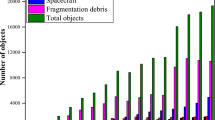Abstract
To improve the survivability of orbiting spacecraft against space debris impacts, we propose an impact damage assessment method. First, a multi-area damage mining model, which can describe damages in different spatial layers, is built based on an infrared thermal image sequence. Subsequently, to identify different impact damage types from infrared image data effectively, the variational Bayesian inference is used to solve for the parameters in the model. Then, an image-processing framework is proposed to eliminate variational Bayesian errors and compare locations of different damage types. It includes an image segmentation algorithm with an energy function and an image fusion method with sparse representation. In the experiment, the proposed method is used to evaluate the complex damages caused by the impact of the secondary debris cloud on the rear wall of the typical Whipple shield configuration. Experimental results show that it can effectively identify and evaluate the complex damage caused by hypervelocity impact, including surface and internal defects.
摘要
为提高在轨航天器抵御空间碎片撞击的生存能力, 提出一种撞击损伤评估方法。首先, 建立一个针对红外热图像序列数据的多区域损伤挖掘模型, 用于描述处于不同空间层的撞击损伤。采用变分贝叶斯推理来求解模型参数, 从而有效地从红外热图像数据中识别不同类型撞击损伤。然后, 提出一种图像处理框架, 包括具有能量函数的图像分割算法和具有稀疏表示的图像融合方法, 以消除变异贝叶斯误差并比较不同类型损伤的位置。在试验部分, 将上述方法用于评估二次碎片云对Whipple防护结构的复杂撞击损伤。实验结果证明本文提出的方法可以对空间碎片超高速撞击造成的不同类型复杂损伤进行有效识别与评估。
Similar content being viewed by others
Explore related subjects
Discover the latest articles and news from researchers in related subjects, suggested using machine learning.References
Chen SY, Cheng ZY, Liu C, 2019. A blind stopping condition for orthogonal matching pursuit with applications to compressive sensing radar. Signal Process, 165:331–342. https://doi.org/10.1016/J.SIGPRO.2019.07.022
Gao B, Woo WL, Tian GY, et al., 2016a. Electromagnetic thermography nondestructive evaluation: physics-based modeling and pattern mining. Sci Rep, 6:25480. https://doi.org/10.1038/srep25480
Gao B, Woo WL, He YZ, et al., 2016b. Unsupervised sparse pattern diagnostic of defects with inductive thermography imaging system. IEEE Trans Ind Inform, 12(1):371–383. https://doi.org/10.1109/TII.2015.2492925
Geng XR, Ji LY, Sun K, 2016. Non-negative matrix factorization based unmixing for principal component transformed hyperspectral data. Front Inform Technol Electron Eng, 17(5):403–412. https://doi.org/10.1631/FITEE.1600028
Guo ZB, Zhang Y, 2019. A sparse corruption non-negative matrix factorization method and application in face image processing & recognition. Measurement, 136:429–437. https://doi.org/10.1016/j.measurement.2018.12.087
Huang XG, Yin C, Ru HQ, et al., 2020. Hypervelocity impact damage behavior of B4C/Al composite for MMOD shielding application. Mater Des, 186:108323. https://doi.org/10.1016/J.MATDES.2019.108323
Kang B, Zhu WP, Liang D, et al., 2019. Robust visual tracking via nonlocal regularized multi-view sparse representation. Patt Recogn, 88:75–89. https://doi.org/10.1016/j.patcog.2018.11.005
Kokkinos Y, Margaritis KG, 2018. Managing the computational cost of model selection and cross-validation in extreme learning machines via Cholesky, SVD, QR and eigen decompositions. Neurocomputing, 295:29–45. https://doi.org/10.1016/J.NEUCOM.2018.01.005
Kullback S, Leibler RA, 1951. On information and sufficiency. Ann Math Stat, 22(1):79–86. https://doi.org/10.1214/AOMS/1177729694
Li X, Sun J, Xiao F, 2016. An efficient prediction framework for multi-parametric yield analysis under parameter variations. Front Inform Technol Electron Eng, 17(12):1344–1359. https://doi.org/10.1631/FITEE.1601225
Liou JC, Johnson NL, 2006. Risks in space from orbiting debris. Science, 311(5759):340–341. https://doi.org/10.1126/science.1121337
Ma XL, Hu SH, Liu SQ, et al., 2018. Multi-focus image fusion based on joint sparse representation and optimum theory. Signal Process Image Commun, 78:125–134. https://doi.org/10.1016/J.IMAGE.2019.06.002
Peng YG, Ganesh A, Wright J, et al., 2012. RASL: robust alignment by sparse and low-rank decomposition for linearly correlated images. IEEE Trans Patt Anal Mach Intell, 34(11):2233–2246. https://doi.org/10.1109/TPAMI.2011.282
Sasmaz E, Mingle K, Lauterbach J, 2015. High-throughput screening using Fourier-transform infrared imaging. Engineering, 1(2):234–242. https://doi.org/10.15302/J-ENG-2015040
Sun J, Chen QD, Sun JN, 2019. Graph-structured multitask sparsity model for visual tracking. Inform Sci, 486:133–147. https://doi.org/10.1016/j.ins.2019.02.043
Wang ZY, Zhu R, Fukui K, 2018. Cone-based joint sparse modelling for hyperspectral image classification. Signal Process, 144:417–429. https://doi.org/10.1016/j.sigpro.2017.11.001
Wu T, Shi J, Jiang XM, et al., 2018. A multi-objective memetic algorithm for low rank and sparse matrix decomposition. Inform Sci, 468:172–192. https://doi.org/10.1016/j.ins.2018.08.037
Yang Y, Cong XC, Long KY, et al., 2018. MRF model-based joint interrupted SAR imaging and coherent change detection via variational Bayesian inference. Signal Process, 151:144–154. https://doi.org/10.1016/j.sigpro.2018.05.007
Yin C, Xue T, Huang XG, et al., 2019. Research on damages evaluation method with multi-objective feature extraction optimization scheme for M/OD impact risk assessment. IEEE Access, 7:98530–98545. https://doi.org/10.1109/ACCESS.2019.2930114
Zhang HN, Huang XG, Yin C, et al., 2020. Design of hypervelocity-impact damage evaluation technique based on Bayesian classifier of transient temperature attributes. IEEE Access, 8:18703–18715. https://doi.org/10.1109/ACCESS.2020.2968398
Zong JJ, Qiu TS, Li WS, 2019. Automatic ultrasound image segmentation based on local entropy and active contour model. Comput Math Appl, 78(3):929–943. https://doi.org/10.1016/J.CAMWA.2019.03.022
Author information
Authors and Affiliations
Corresponding author
Additional information
Project supported by the National Natural Science Foundation of China (No. 61873305) and the Applied Basic Research Program of Sichuan Province, China (Nos. 2018JY0410 and 2019YJ0199)
Contributors
Xuegang HUANG designed the research. Xuegang HUANG and Anhua SHI processed the infrared thermal image sequence data. Jinyang LUO and Qing LUO designed the hypervelocity impact experiment. Xuegang HUANG drafted the paper. Anhua SHI helped organize the paper. Xuegang HUANG revised and finalized the paper.
Compliance with ethics guidelines
Xuegang HUANG, Anhua SHI, Qing LUO, and Jinyang LUO declare that they have no conflict of interest.
Rights and permissions
About this article
Cite this article
Huang, X., Shi, A., Luo, Q. et al. Variational Bayesian multi-sparse component extraction for damage reconstruction of space debris hypervelocity impact. Front Inform Technol Electron Eng 23, 530–541 (2022). https://doi.org/10.1631/FITEE.2000575
Received:
Accepted:
Published:
Issue Date:
DOI: https://doi.org/10.1631/FITEE.2000575



